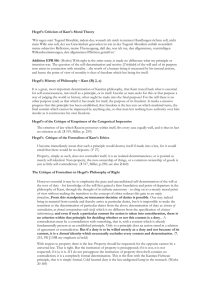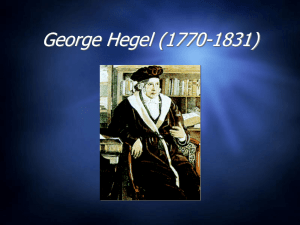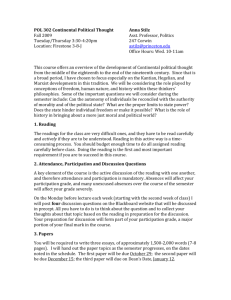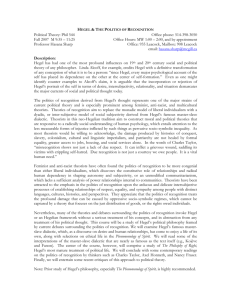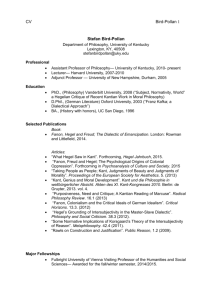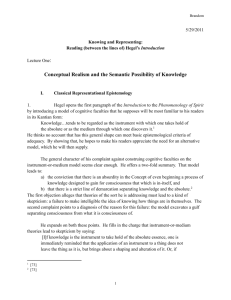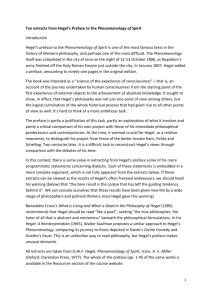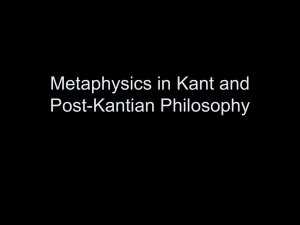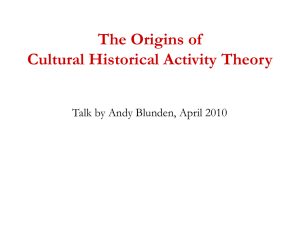Handout
advertisement
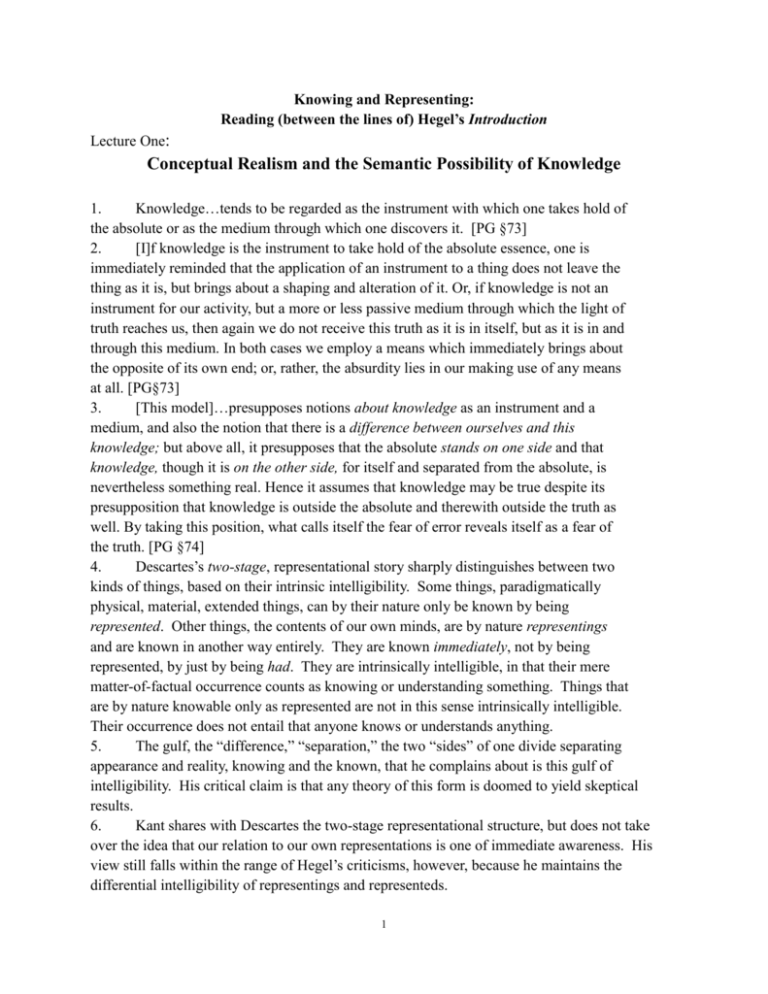
Knowing and Representing: Reading (between the lines of) Hegel’s Introduction Lecture One: Conceptual Realism and the Semantic Possibility of Knowledge 1. Knowledge…tends to be regarded as the instrument with which one takes hold of the absolute or as the medium through which one discovers it. [PG §73] 2. [I]f knowledge is the instrument to take hold of the absolute essence, one is immediately reminded that the application of an instrument to a thing does not leave the thing as it is, but brings about a shaping and alteration of it. Or, if knowledge is not an instrument for our activity, but a more or less passive medium through which the light of truth reaches us, then again we do not receive this truth as it is in itself, but as it is in and through this medium. In both cases we employ a means which immediately brings about the opposite of its own end; or, rather, the absurdity lies in our making use of any means at all. [PG§73] 3. [This model]…presupposes notions about knowledge as an instrument and a medium, and also the notion that there is a difference between ourselves and this knowledge; but above all, it presupposes that the absolute stands on one side and that knowledge, though it is on the other side, for itself and separated from the absolute, is nevertheless something real. Hence it assumes that knowledge may be true despite its presupposition that knowledge is outside the absolute and therewith outside the truth as well. By taking this position, what calls itself the fear of error reveals itself as a fear of the truth. [PG §74] 4. Descartes’s two-stage, representational story sharply distinguishes between two kinds of things, based on their intrinsic intelligibility. Some things, paradigmatically physical, material, extended things, can by their nature only be known by being represented. Other things, the contents of our own minds, are by nature representings and are known in another way entirely. They are known immediately, not by being represented, by just by being had. They are intrinsically intelligible, in that their mere matter-of-factual occurrence counts as knowing or understanding something. Things that are by nature knowable only as represented are not in this sense intrinsically intelligible. Their occurrence does not entail that anyone knows or understands anything. 5. The gulf, the “difference,” “separation,” the two “sides” of one divide separating appearance and reality, knowing and the known, that he complains about is this gulf of intelligibility. His critical claim is that any theory of this form is doomed to yield skeptical results. 6. Kant shares with Descartes the two-stage representational structure, but does not take over the idea that our relation to our own representations is one of immediate awareness. His view still falls within the range of Hegel’s criticisms, however, because he maintains the differential intelligibility of representings and representeds. 1 7. Kant has a new model of intelligibility: to be intelligible is to have a content articulated by concepts. 8. Hegel learned from Kant that the soft underbelly of epistemological theories is the semantics they implicitly incorporate and depend upon. And he thinks that two-stage representational theories committed to the strong differential intelligibility of representings and what they represent semantically preclude genuine knowledge of those representeds. 9. The “Genuine Knowledge Condition” (GKC): Epistemological theories must not be committed to a semantics—in particular, a theory of representation—that rules out as unintelligible the very possibility of knowing how things really are (“genuine” knowledge). 10. The Intelligibility of Error Condition (IEC): Epistemological theories must make intelligible the possibility of error. 11. The Mode of Presentation Condition (MPC): Appearances (senses, representings) must be essentially, and not just accidentally, appearances of some purported realities. One does not count as having grasped an appearing unless one grasps it as the appearance of something. 12. The Rational Constraint Condition (RCC): Any adequate theory of representation must portray what is represented as exerting rational constraint on representings of it. That is, how it is with what is represented must, when the representation relation is not defective, provide a reason for the representing to be as it is. 13. Hegel learns from Kant to think about representation in normative terms. What is represented exercises a distinctive kind of authority over representings. Representings are responsible to what they represent. What is represented serves as a kind of normative standard for assessments of the correctness of what count as representings of it (correct or incorrect) just in virtue of being subject to assessments of their correctness in which those representeds provide the standard. 14. If the RCC must be satisfied in order to satisfy the GKC and the IEC (if the RCC really is a semantically necessary condition on satisfying these epistemological criteria of adequacy)— perhaps because it is a necessary condition of satisfying the MPC, which itself is a necessary semantic condition on satisfying the GKC and the IEC—then those conditions cannot be satisfied by a two-stage representational theory that is committed to the strong differential intelligibility of representing and represented. If not only representings, but the representation relation must be intelligible in a sense that requires their conceptual articulation, then both ends of the representation relation must be conceptually contentful. Only in that way is it intelligible how what is represented can exert rational constraint on representings, in the sense of providing reasons for assessments of their correctness or incorrectness. 15. “When we say, and mean, that such-and-such is the case, we—and our meaning—do not stop anywhere short of the fact; but we mean: this—is—so.” [Philosophical Investigations §95] 16. Hegel gets his concept of conceptual content from thinking about Kant’s theory of judgment, and taking on board his understanding of concepts as functions of judgment. Kant understands judging in normative and pragmatic terms. On the normative side, he understands judging as committing oneself, taking responsibility for something, endorsing the judged content. 2 On the pragmatic side, he understands these normative doings in practical terms: as a matter of what one is committed or responsible for doing. What on is responsible for doing is integrating the endorsed content into a constellation of other commitments that exhibits the distinctive unity of apperception. 17. Hegel’s non-psychological conception of the conceptual understands conceptual content as articulated by relations of material incompatibility (“determinate negation”) and material consequence (“mediation”). 18. Not only thoughts, but objective properties, and so the facts concerning which objects exhibit which properties, also stand in relations of material incompatibility and consequence. 19. Modal realism, the claim that some states of affairs necessitate others and make others impossible, the acknowledgment of laws of nature, entails conceptual realism: the claim that the way the world objectively is is conceptually articulated. 20. Hegel thinks that the idea of determinateness itself is to be understood in terms of standing in relations of incompatibility and consequence to other things that are determinate in the same sense. He endorses Spinoza’s principle “Omnis determinatio est negatio.” 21. The relations of material incompatibility and consequence in virtue of which objective facts and properties are determinate are alethic modal relations: a matter of what is conditionally (im)possible and necessary. The relations of material incompatibility and consequence in virtue of which the commitments undertaken and predicates applied by discursive subjects are determinate are deontic normative relations: a matter of what one is conditionally entitled and committed to. 22. What one needs to do in order thereby to count as practically taking or treating two objective states of affairs (or properties) as alethically incompatible is to acknowledge that if one finds oneself with both the corresponding commitments, one is deontically obliged to reject or reform at least one of them. 23. In this lecture I have aimed to do six things: To demarcate explicitly the exact range of epistemological theories, epitomized by those of Descartes and Kant, that fall within the target-area of Hegel’s criticism; To set out clearly the objection that he is making to theories of that kind, in a way that does not make it obviously miss its mark; To formulate Hegel’s criteria of adequacy for a theory that would not be subject to that objection he is implicitly putting in play; To lay out the non-psychological conception of the conceptual that will form the backbone of Hegel’s response (even though it is not officially introduced in the Introduction itself, but must wait for the opening chapters of Consciousness); To sketch the general outlines of an epistemological and semantic approach based on that conception of the conceptual; To indicate how such an approach might satisfy the criteria of adequacy for a theory that is not subject to Hegel’s objection. 3
